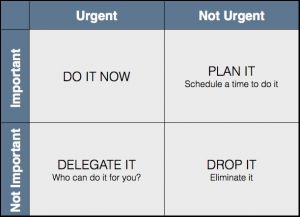
Continuing our series about the 7 Habits of Highly Effective Marketers, based on Stephen Covey’s principles, this week we’ll discuss the third habit: “Put first things first.” (If you missed our last two installments, you can find them here: Do You Know the 7 Habits of Highly Effective Marketers? and It’s Important to Begin With the End in Mind.)
“Put first things first” is not about time management. According to Covey, it is about priority management. Marketers, like other business professionals, juggle many tasks at once—email campaigns, brand management, prospect outreach, content creation. The list is endless. Deciding which should come first is a daily hurdle.
The Eisenhower Method
There are many methods of time and priority management that have been developed over the years. But the priority management Covey described comes from Dwight D. Eisenhower. Eisenhower said, “I have two kinds of problems, the urgent and the important. The urgent are not important, and the important are never urgent.” This approach provides a framework for evaluating tasks in a simple matrix.

Using the decision matrix, prioritize actions based on four possibilities:
Important/Urgent. These are tasks and responsibilities that every successful marketer needs to do immediately and personally. They require current action and can include crises, fixed deadlines, challenges to overcome and other initiatives where lack of attention can have a swift and negative impact on the accomplishment of key marketing goals and initiatives.
Important/Not Urgent. These are tasks and activities that have been planned. They too require personal action. Examples include tactics such as competition review, branding initiatives, professional development. All of these are written into the marketing plan with a specific completion date identified. Prioritization of end dates should be a part of any plan and can be reviewed and revised as needed.
Unimportant/Urgent. These are tasks and activities that are easy to delegate. Some are necessary, such as requests from others, attendance and participation in committee meetings and product or program reviews. Let others handle updates and routine interruptions.
Unimportant/Not Urgent. The activities in this quadrant are time wasters and represent other trivialities. These tasks may include attending unnecessary meetings, checking personal social media, mindlessly surfing the internet and reading non-business-related materials. Eliminate anything that falls into this category.
Priority Management: Stick to a Plan
Sudden urgent tasks can sometimes take our attention away and feel important. But an essential skill is being able to distinguish what is not only urgent, but also truly important. Using the four quadrant framework to prioritize routine tasks improves performance and effectiveness. For example, the average employee checks email 36 times an hour. Furthermore, there’s an average of 16 minutes spent refocusing after handling an incoming email. That time adds up quickly. Prioritization management directs time toward tasks that are important and contribute toward your long-term mission, goals and values.
We always stress the importance of a creating and following a marketing plan as a vehicle to accomplish defined goals. Putting first things first helps to put marketing tactics, programs and activities into perspective. With an eye on importance and urgency, be discerning. Question whether every step and action are truly necessary, and don’t hesitate to do away with tasks that don’t contribute to overall success.
Every plan should start with two questions:
1) What do you hope to achieve?
2) How do you hope to achieve it?
The first question defines your overall strategy: what is the end goal? What values drive that goal? The second question defines your tactics: what methods, programs and tools help you to achieve that strategy? Before you’re able to further break down your tactics into a step-by-step plan, prioritization is a must. This can require prior knowledge, experience, outside expertise, research or basic trial and error. It’s important to know that priorities will change over time, and continuing to revisit and revise strategies and the tactics used to achieve them is vital.
Avoid the Hamster on the Wheel Phenomenon

The typical workday requires effective marketers to take a step back. It’s crucial to determine what the priorities are and what’s essential to accomplish in any given day. Without this focus, it is easy to get stuck in a hamster wheel fueled by distractions and unproductive tasks. Finding tactics that work for you to help define priorities can mean the difference between productivity and simply keeping busy. What are you doing to ensure each moment of your time and your employees’ time is best spent? Whether you use the Eisenhower method of priority management, another framework or develop your own, an effective marketer weighs priorities regularly and puts first things first.


Comments are closed.